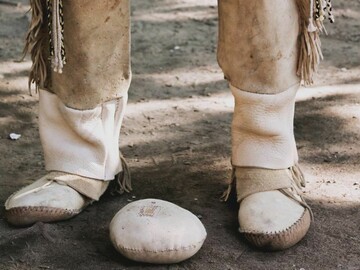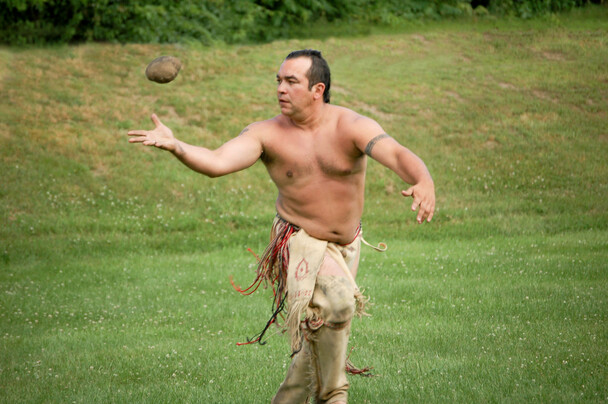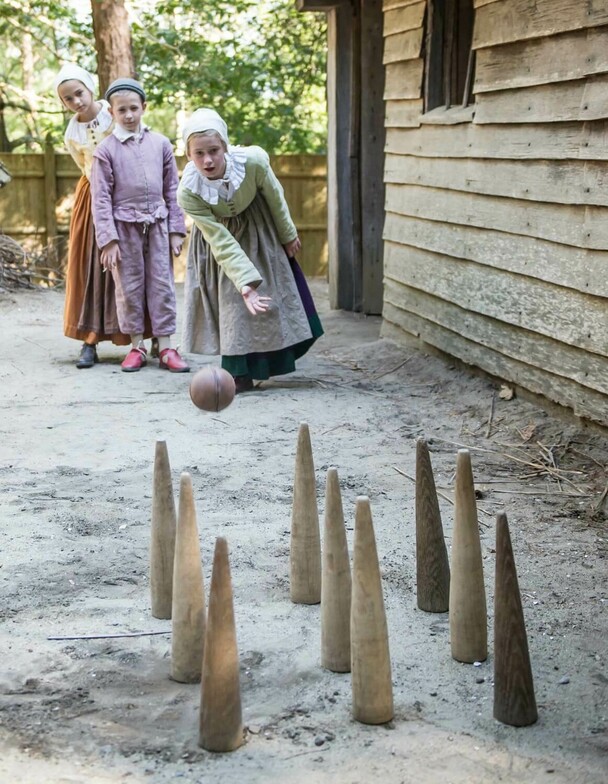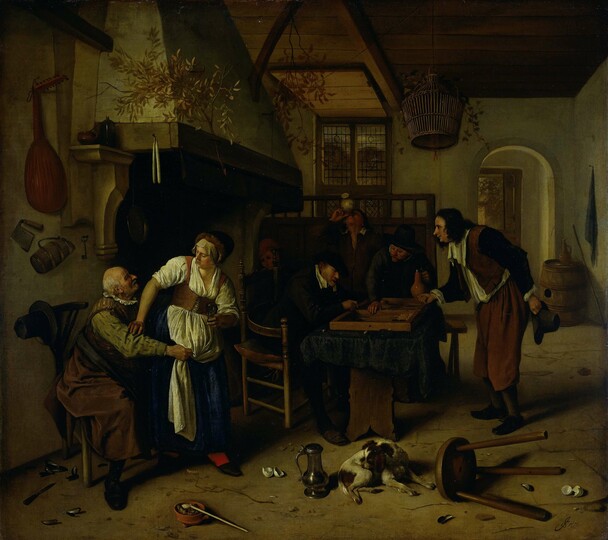“Among Other Recreations”: Games & Sports
- Date
- 2017
- Material
- Photograph
- Author/Maker
- Artist name is no longer known.
- Source
- Plimoth Patuxet Museums

Description
In the single eyewitness account of the 1621 harvest feast, Edward Winslow remembers that after the men assigned to go fowling returned with enough birds to feed the colony for several days, they engaged in “recreations.” The only activity specifically mentioned is military exercises, likely to show off the new allies firepower, but what other games may have been played that fall in New Plymouth? With at least ninety Native men in attendance, what Indigenous pastimes did they contribute to the three days of entertainment? And what did the two communities think about other recreations, games and sports in general?
Like other cultures, 17th-century Wampanoag people were no strangers to the need for amusement. Recreation took three basic forms: (1) Games involving various degrees of physical skill; (2) Games of chance, and (3) Toys.
According to the late Native historian Nanepashemet, very little information on 17th-century Native games survives, due to the interruption in the transmission of games across generations and lack of English accounts, but it is apparent from comparison with other Native People that the southern New England people had a variety of recreations. The greatest lack of information relates to women’s and children’s recreations.1
Some games may have had ritual significance and were only used in relation to ceremonies, though some of these may also have had counterparts that were more secular in nature. English colonist Roger Williams (1603-1683) wrote that the Natives of southern New England had two sorts of games: public and private. In other words, some games involved community participation, and others involved just a few individuals. Williams commented that, “Their public Games are solemnized with the meeting of hundreds; sometimes thousands.”2
Games that involved the participation of large groups, especially with players from two or more communities, may have had strong ceremonial importance. These games, either sports of physical activity or games of chance, probably expressed the relationship of the groups involved. In some cases, the games may have served as ritual substitutes for war.
Gambling was a common feature of many games. Though frowned on by English clergymen, the wagering of goods on the outcome of such games as football, the bowl game, and the rushes game appears to have been an essential part of the games.
Gambling was not considered immoral by Indigenous people; rather it was met with great enthusiasm. There may have been some ritual meaning behind gambling which not only allowed it, but even encouraged the custom. Gambling also had the effect of circulating wealth throughout the community. Items which might be wagered in games included skins, knives, hatchets, wampum, clothing, houses, corn, kettles, even the gamblers themselves. Roger Williams mentioned that some of the gamblers possessed for luck, “a piece of Thunderbolt, which is like unto a Crystal, which they dig out of the ground under some tree Thunder-smitten, and from this stone they have an opinion of successe.”3
The play of children receives little attention from English colonial writers. It may be inferred with some degree of confidence that their activities generally imitated adult behavior and prepared them for their future roles in the communities. Boys’ games centered upon the physical and mental requirements of hunters, fishermen, and warriors. Girls’ games likely mimicked household duties. It can be safely assumed that they experienced a lot of physical activity and that their play changed as they grew older.
Though often reputed to have had a dim view of games or fun, reformed English Christians were not entirely against recreation. In the 1600s, English people played games or sports as a relief from work, to encourage imagination, as part of a celebration, and to encourage competition. Popular adult games included bowling, tennis, football (soccer), stoolball, wrestling, pitching the bar, and blindman-bluff as well as board games such as chess, draughts (checkers), and nine-men’s morris. Children might have played with toys like stilts, pinwheels, tops, hoops, bubbles, and marbles.
English Christians did, however, have definite opinions on what sports and games ought – and ought not – to be played. Presbyterian preacher and physician Alexander Leighton (c.1650-1649) approved of any “recreation” for the renewal, repair, recovery, and refreshment of the body or mind (or both). He believed that God allowed five types of recreation: “rest from labor,” “food and drink,” “sleep,” “change of labor,” and “music.”4Another 17th-century minister, William Perkins (1558-1602), liked games of “wit and industry” to develop the body or mind as well as more vigorous games played in moderation such as shooting the longbow and caliver (a short musket), running, fencing, music, and the philosopher’s game (a strategy game like chess). For Perkins, the ends had to justify the means. He advised his readers “to make choice of recreations which are of the least offense, and of the best report [result].”5Puritans did not disapprove of games, but only of excessive gaming that did little to benefit the player or God. Like many reformed ministers and their congregations, Perkins strongly disapproved of plays, dancing (particularly men and women dancing together), bear baits, cock fights, and any gambling games.6
In 1621, Plymouth colonists had little time for recreation. Following Perkins’ suggestions, however, they had plenty of possibilities when they did have time.
Transcription
The Bowl Game
The Indigenous people of 17th-century New England played versions of this game. The pieces consist of a wooden bowl and flat, marked playing pieces often compared to European dice. Englishman William Wood (in Massachusetts, 1629-1634) describes the “bowl game” which he calls “hubbub” after the chants of spectators and participants:
“Hubbub is five small bones in a small smooth tray, the bones be like a Die, but something flatter, black on the one side and white on the other, which they place on the ground, against which violently thumping the platter, the bones mount changing colors with the windy whisking of their hands to and fro; which action in that sport they much use, smiting themselves on the breast, and thighs, crying out Hub, Hub, Hub....The bones being all black or white, make a double game; if three be of a color and two of another, then they afford but a single game; four of a color and one differing is nothing; so long as a man wins, he keeps the tray: but if he lose, the next man takes it.”7
Roger Williams also gives a brief description:
“they have a kind of Dice which are Plumb [plum] stones painted, which they cast in [a] Tray, with a mighty noise and sweating.”8
It is unknown if the game as observed by William Wood was played with the same rules as that seen by RogerWilliams. Williams was familiar with Native People from Massachusetts Bay to the Connecticut River, but his aversion to gambling kept him from fully observing and documenting the game.
Children’s Games in New Plymouth
While children in Plymouth were expected to work and contribute to the household, they still had time to play. Many of the games that English children enjoyed are familiar today, like hide and seek, skipping rope, marbles and blind man’s bluff. Try your hand at children’s games.
Ring-Taw
At least two, but more can play
A circle is drawn on the ground. Each player places in it an equal number of marbles. A line called the “taw” is drawn at a distance from the ring. Each player bowls a marble towards the ring. The one whose marble comes nearest to the ring has the first chance to shoot a marble from the taw into the ring. If he knocks out a marble, he keeps it and continues shooting until he misses. Then the person whose marble was next nearest plays, and so on. If a taw marble stays in the ring after being shot, the player must replace all of the marbles he had knocked out of the ring.
Hunt the Slipper
At least six, a large number can play
Players sit in a circle. One player has to leave while the others hide a slipper or other object under the knees of one of their number. When the player returns the seated players pass the object around secretly so as to prevent him or her from seeing who has it. When the object is at last located, the guesser exchanges places with the person who had it and the game starts again.
Media
Discussion Questions
-
Why play games?
-
What games do you play and for what purpose?
-
When is it ok to play games and what kinds of games are ok? When is it not?
-
Do adults play games and are there games just for children?
Footnotes
- 1 Much of the information in this article is drawn from Nanepashemet, “Games & Amusements of the Wampanoag,” Handbook for the Wampanoag Homesite (internal Plimoth Patuxet Museums publication).
- 2 Roger Williams, A Key Into the Language of America (London: Printed by Gregory Dexter, 1643), 169.
- 3 Ibid., 170.
- 4 Ibid., 13-16.
- 5 Ibid., 592-593.
- 6 William Perkins, The Whole Treatise of the Cases of Conscience, Vol. 2 (Cambridge: John Legat, 1606), 586-590.
- 7 William Wood, New England’s Prospect (London: John Dawson for John Bellamy, 1639), 73.
- 8 Williams, 169-171.


